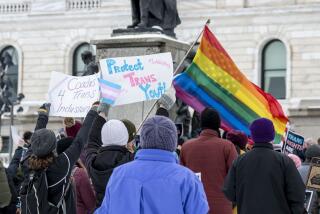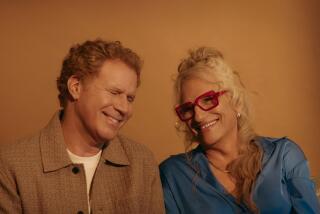In Netflix’s ‘She-Ra,’ even villains respect nonbinary pronouns
Since its debut, “She-Ra and the Princesses of Power” has subverted traditional expectations of what it means to be a “princess.”
In Etheria, the setting of the DreamWorks/Netflix animated series, princesses with magical superpowers rebel against the Evil Horde. This includes Adora, whose mythical sword transforms her into the powerful (and physically imposing) She-Ra, and Glimmer, now the leader of the Princess Alliance, who wields sparkly energy blasts and can teleport.
They’re just two of the many princesses in the “She-Ra” reboot — with talents and interests ranging from sleuthing and conducting scientific experiments to meditating and ice sculpting. Some princesses are attracted to boys, while others are dating fellow princesses. And the show’s beloved villains are no less diverse.
Now, in its fourth season, which premiered Tuesday, “She-Ra” has introduced its first nonbinary character, a shapeshifter named Double Trouble.
“Double Trouble is just a mischievous little chaotic being that causes all kinds of trouble for basically everybody,” said Jacob Tobia, the nonbinary performer and writer who voices the character. “They’re fearless and deeply in touch with their own power and aren’t scared of pretty much anyone in Etheria.”
As a mercenary, “Double Trouble is sort of figuring out how they want to play this whole rivalry” between the Horde and the Princess Alliance when you first meet them, added Tobia. “By the end [of the season], they’ve made some choices.”
Tobia auditioned for the role before the series premiered. As soon as they booked the part, they watched episodes of the original ’80s cartoon to get a sense of the show’s roots. When they were finally shown the reboot’s first episode in advance of its Netflix premiere last fall, Tobia could see how Double Trouble fit perfectly into “She-Ra’s” universe.
“The beauty of this series is that Double Trouble joining as a nonbinary character in Season 4 is not out of nowhere,” Tobia said. “They’re coming into a world that has been flexing with gender norms and creating a more expansive understanding of gender from the get-go. From the pilot of this series, gender does not work in the same restrictive ways we’re used to it working.”
Although there was a Double Trouble toy (and backstory), the character did not appear in the original “She-Ra” cartoon. For “She-Ra and the Princesses of Power” showrunner Noelle Stevenson, introducing Double Trouble wasn’t a matter of if but when.
“Double Trouble was one of those characters that I knew I wanted to find a place for in the story one way or another,” said Stevenson. “The character is a shapeshifter, and I love shapeshifters. Like, they’re my favorite type of character to write.”
Stevenson, whose Eisner Award-nominated graphic novel “Nimona” is about a shapeshifting sidekick to a supervillain, can trace her affinity for the archetype to one specific character: Zam Wessell, from 2002’s “Star Wars: Episode II — Attack of the Clones.”
Intrigued by the idea of a female bounty hunter like Wessell, Stevenson said she was obsessed even before seeing the film. In her brief appearance, Wessell was revealed to be a shapeshifting reptilian alien before quickly being killed.
“I like latched onto that really, really hard as a kid,” said Stevenson, who credits the character for shaping a lot of her storytelling. “She’s just become such a crucial part of my DNA, this bit ‘Star Wars’ character. Double Trouble is just another homage to Zam Wessell, my No. 1 favorite character in the world.”
“She-Ra” Season 4 sees many characters’ bonds of friendship put to the test — on top of the line between good and evil getting further blurred — which made it a perfect time to introduce a more morally ambiguous character like Double Trouble. They have plenty to do, none of it limited to educating others about nonbinary issues.
“‘She-Ra’ is built for a generation that doesn’t need that kind of education in the same way anymore,” said Tobia. “Young people in Generation Z know who nonbinary people are, they know what they/them pronouns are. They know that gender is a spectrum, not a binary. They already know this.”
That means everybody in Etheria already knows this too, including the leader of the Evil Horde.
“The thing that was really gratifying in a very surprising way for me is a scene where Hordak talks about Double Trouble and just says ‘they’ effortlessly, with no thought, and just uses gender-neutral pronouns,” said Tobia. “Even the most evil person on the planet doesn’t misgender people, because that would be rude. There’s something really cool about that.
“Also, if Hordak can use they/them pronouns appropriately, I think anyone can. Do you really want to be worse than Hordak by misgendering nonbinary people? No, you don’t.”
As Tobia acknowledged, Double Trouble follows in the footsteps of other animated shows that have paved the way with regards to transgender and nonbinary representation. This includes animated characters that were never explicitly gendered as well as groundbreaking shows such as “Danger & Eggs,” cocreated by transgender showrunner Shadi Petosky, which featured the nonbinary character Milo (voiced by nonbinary actor and advocate Tyler Ford).
Additionally, “Steven Universe,” whose creator Rebecca Sugar identifies as a nonbinary woman, features alien Gems who are all nonbinary women.
“I don’t want to pretend as if animation and kids animation hasn’t been a source of gender play since its inception,” said Tobia. “There have been hundreds of gender nonconforming characters who have had unspecified genders or different genders or complicated genders across so many different shows.”
They added: “Queer and trans people have been working in animation and have been influencing how kids animation looks and what the worlds of kids animation are for a really, really long time. This is only an extension of all of that work. It’s a next step in a much longer journey.”
While Double Trouble was not created specifically to educate viewers on nonbinary issues, Stevenson recognizes that approach is legitimate (and important) — while pointing out that it can also be limiting, since it often requires characters to be close to perfect.
One way to avoid that dilemma is by creating an inclusive universe like Etheria, where gender isn’t constricted and heteronormativity doesn’t exist. In a sci-fi/fantasy show where magical powers and interdimensional space travel exist, it shouldn’t be a stretch to believe queer and gender nonconforming people do too — whether as protagonists or antagonists.
“We wanted to make a character who was really dimensional and not 100% good or nice all the time,” said Stevenson. “We want to have those compelling characters who aren’t so squeaky clean. We want the messy characters. We want the antiheroes. We want the villains.”
More to Read
The complete guide to home viewing
Get Screen Gab for everything about the TV shows and streaming movies everyone’s talking about.
You may occasionally receive promotional content from the Los Angeles Times.







